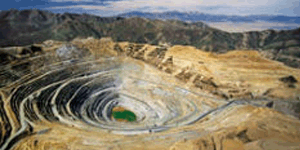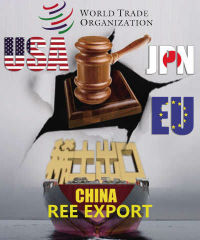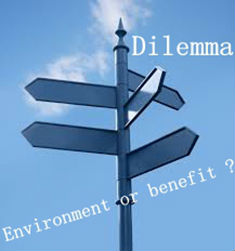- Rare earths: industry dilemma
 REE can be widely used in many areas including magnets, catalysts, metal alloys, electronics, glass, ceramics, new materials and some other high-technology fields. Meanwhile, rare earth extraction is one of the most environmentally destructive and toxic of all mining practices. Excessive rare earth mining has resulted in landslides, clogged rivers, environmental pollution emergencies and even major accidents and disasters, causing great damage to people's safety and health and the ecology of the environment. According to studies conducted within the Baotou region of Inner Mongolia, where China's primary rare earth production occurs, the rare earth enterprises together produce approximately ten million tonnes of wastewater every year and most of it is discharged without being effectively treated. In addition, each tonne of rare earths produces 2,000 tonnes of mine tailings, which often contain radioactive thorium.
REE can be widely used in many areas including magnets, catalysts, metal alloys, electronics, glass, ceramics, new materials and some other high-technology fields. Meanwhile, rare earth extraction is one of the most environmentally destructive and toxic of all mining practices. Excessive rare earth mining has resulted in landslides, clogged rivers, environmental pollution emergencies and even major accidents and disasters, causing great damage to people's safety and health and the ecology of the environment. According to studies conducted within the Baotou region of Inner Mongolia, where China's primary rare earth production occurs, the rare earth enterprises together produce approximately ten million tonnes of wastewater every year and most of it is discharged without being effectively treated. In addition, each tonne of rare earths produces 2,000 tonnes of mine tailings, which often contain radioactive thorium. China, which possesses 23% of the world's rare earth reserves and provides more than 90 percent of the world's supplies, has suffered environmental damage from the mining and processing and depletion of the resource. Because of this, in recent years, China has announced production caps, stricter environmental standards, an export quota system for rare earth metals and some other policies related to REE mining and exports. It has also implemented a number of measures to improve the sustainable development of the industry. The implementation of new standards reduced exports of rare earths in the first half of 2011 by 35 percent, following a 72 percent reduction during the second half of the previous year. China says it's being stingy for environmental reasons, not economic leverage, but the cutbacks have nonetheless caused major price spikes.
China, which possesses 23% of the world's rare earth reserves and provides more than 90 percent of the world's supplies, has suffered environmental damage from the mining and processing and depletion of the resource. Because of this, in recent years, China has announced production caps, stricter environmental standards, an export quota system for rare earth metals and some other policies related to REE mining and exports. It has also implemented a number of measures to improve the sustainable development of the industry. The implementation of new standards reduced exports of rare earths in the first half of 2011 by 35 percent, following a 72 percent reduction during the second half of the previous year. China says it's being stingy for environmental reasons, not economic leverage, but the cutbacks have nonetheless caused major price spikes.  And these moves have triggered protests from several countries who claim that China is using the precious metals, which are used to manufacture an array of high-tech goods, as a political bargaining chip. And these restrictions have affected normal competition within the international REE market. On 13th March 2012, the European Union launched a second challenge to China's export restrictions on raw materials covering 17 rare earths, as well as tungsten and molybdenum. Together with the United States and Japan, the European Union formally requested dispute settlement consultations with China at the WTO. The WTO ruled on March 26th, 2014 that China had acted inconsistently with WTO rules with regards to the export measures imposed on the rare earth materials.
And these moves have triggered protests from several countries who claim that China is using the precious metals, which are used to manufacture an array of high-tech goods, as a political bargaining chip. And these restrictions have affected normal competition within the international REE market. On 13th March 2012, the European Union launched a second challenge to China's export restrictions on raw materials covering 17 rare earths, as well as tungsten and molybdenum. Together with the United States and Japan, the European Union formally requested dispute settlement consultations with China at the WTO. The WTO ruled on March 26th, 2014 that China had acted inconsistently with WTO rules with regards to the export measures imposed on the rare earth materials.  In an effort to reduce their dependence on foreign imported oil and natural gas, many countries are turning more and more to green technologies, all of which require an abundance of REEs. Neodymium, one of the most common rare earths, is a key part of magnets used in hyper-efficient motors and generators. Around two tonnes of neodymium is needed for each wind turbine. Lanthanum is a major ingredient for hybrid car batteries (each Prius uses up to 15 kg), while terbium is vital for low-energy light bulbs and cerium is used in catalytic converters. The fact that REEs are needed for green technologies is shrouded in irony because of the great potential environmental implications of mining and processing them.
In an effort to reduce their dependence on foreign imported oil and natural gas, many countries are turning more and more to green technologies, all of which require an abundance of REEs. Neodymium, one of the most common rare earths, is a key part of magnets used in hyper-efficient motors and generators. Around two tonnes of neodymium is needed for each wind turbine. Lanthanum is a major ingredient for hybrid car batteries (each Prius uses up to 15 kg), while terbium is vital for low-energy light bulbs and cerium is used in catalytic converters. The fact that REEs are needed for green technologies is shrouded in irony because of the great potential environmental implications of mining and processing them.- Source: www.periodni.com/rare_earth_elements.html; news.xinhuanet.com/english/china/2012-04/08/c_131513730.htm; europa.eu/rapid/press-release_IP-12-239_en.htm
-
About us
Contact us
Make a suggestion
- Metalpedia is a non-profit website, aiming to broaden metal knowledge and provide extensive reference database to users. It provides users reliable information and knowledge to the greatest extent. If there is any copyright violation, please notify us through our contact details to delete such infringement content promptly.
 REE can be widely used in many areas including magnets, catalysts, metal alloys, electronics, glass, ceramics, new materials and some other high-technology fields. Meanwhile, rare earth extraction is one of the most environmentally destructive and toxic of all mining practices. Excessive rare earth mining has resulted in landslides, clogged rivers, environmental pollution emergencies and even major accidents and disasters, causing great damage to people's safety and health and the ecology of the environment. According to studies conducted within the Baotou region of Inner Mongolia, where China's primary rare earth production occurs, the rare earth enterprises together produce approximately ten million tonnes of wastewater every year and most of it is discharged without being effectively treated. In addition, each tonne of rare earths produces 2,000 tonnes of mine tailings, which often contain radioactive thorium.
REE can be widely used in many areas including magnets, catalysts, metal alloys, electronics, glass, ceramics, new materials and some other high-technology fields. Meanwhile, rare earth extraction is one of the most environmentally destructive and toxic of all mining practices. Excessive rare earth mining has resulted in landslides, clogged rivers, environmental pollution emergencies and even major accidents and disasters, causing great damage to people's safety and health and the ecology of the environment. According to studies conducted within the Baotou region of Inner Mongolia, where China's primary rare earth production occurs, the rare earth enterprises together produce approximately ten million tonnes of wastewater every year and most of it is discharged without being effectively treated. In addition, each tonne of rare earths produces 2,000 tonnes of mine tailings, which often contain radioactive thorium. China, which possesses 23% of the world's rare earth reserves and provides more than 90 percent of the world's supplies, has suffered environmental damage from the mining and processing and depletion of the resource. Because of this, in recent years, China has announced production caps, stricter environmental standards, an export quota system for rare earth metals and some other policies related to REE mining and exports. It has also implemented a number of measures to improve the sustainable development of the industry. The implementation of new standards reduced exports of rare earths in the first half of 2011 by 35 percent, following a 72 percent reduction during the second half of the previous year. China says it's being stingy for environmental reasons, not economic leverage, but the cutbacks have nonetheless caused major price spikes.
China, which possesses 23% of the world's rare earth reserves and provides more than 90 percent of the world's supplies, has suffered environmental damage from the mining and processing and depletion of the resource. Because of this, in recent years, China has announced production caps, stricter environmental standards, an export quota system for rare earth metals and some other policies related to REE mining and exports. It has also implemented a number of measures to improve the sustainable development of the industry. The implementation of new standards reduced exports of rare earths in the first half of 2011 by 35 percent, following a 72 percent reduction during the second half of the previous year. China says it's being stingy for environmental reasons, not economic leverage, but the cutbacks have nonetheless caused major price spikes.  And these moves have triggered protests from several countries who claim that China is using the precious metals, which are used to manufacture an array of high-tech goods, as a political bargaining chip. And these restrictions have affected normal competition within the international REE market. On 13th March 2012, the European Union launched a second challenge to China's export restrictions on raw materials covering 17 rare earths, as well as tungsten and molybdenum. Together with the United States and Japan, the European Union formally requested dispute settlement consultations with China at the WTO. The WTO ruled on March 26th, 2014 that China had acted inconsistently with WTO rules with regards to the export measures imposed on the rare earth materials.
And these moves have triggered protests from several countries who claim that China is using the precious metals, which are used to manufacture an array of high-tech goods, as a political bargaining chip. And these restrictions have affected normal competition within the international REE market. On 13th March 2012, the European Union launched a second challenge to China's export restrictions on raw materials covering 17 rare earths, as well as tungsten and molybdenum. Together with the United States and Japan, the European Union formally requested dispute settlement consultations with China at the WTO. The WTO ruled on March 26th, 2014 that China had acted inconsistently with WTO rules with regards to the export measures imposed on the rare earth materials.  In an effort to reduce their dependence on foreign imported oil and natural gas, many countries are turning more and more to green technologies, all of which require an abundance of REEs. Neodymium, one of the most common rare earths, is a key part of magnets used in hyper-efficient motors and generators. Around two tonnes of neodymium is needed for each wind turbine. Lanthanum is a major ingredient for hybrid car batteries (each Prius uses up to 15 kg), while terbium is vital for low-energy light bulbs and cerium is used in catalytic converters. The fact that REEs are needed for green technologies is shrouded in irony because of the great potential environmental implications of mining and processing them.
In an effort to reduce their dependence on foreign imported oil and natural gas, many countries are turning more and more to green technologies, all of which require an abundance of REEs. Neodymium, one of the most common rare earths, is a key part of magnets used in hyper-efficient motors and generators. Around two tonnes of neodymium is needed for each wind turbine. Lanthanum is a major ingredient for hybrid car batteries (each Prius uses up to 15 kg), while terbium is vital for low-energy light bulbs and cerium is used in catalytic converters. The fact that REEs are needed for green technologies is shrouded in irony because of the great potential environmental implications of mining and processing them.